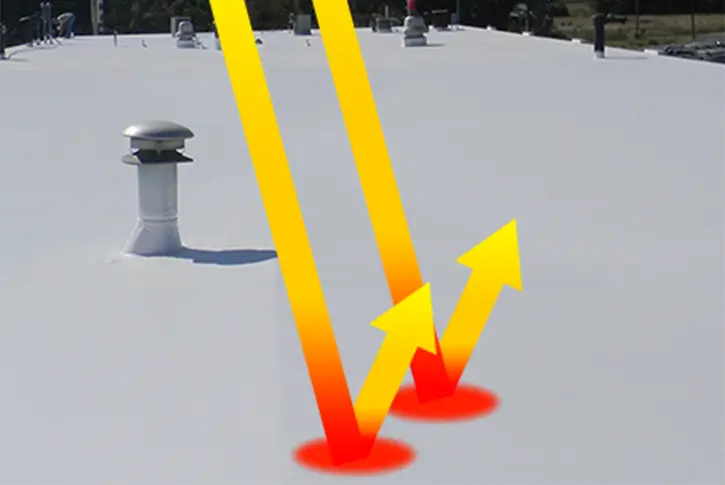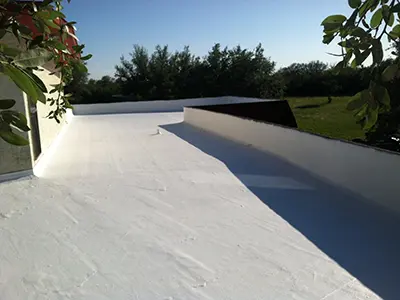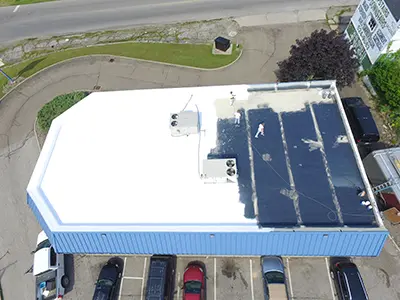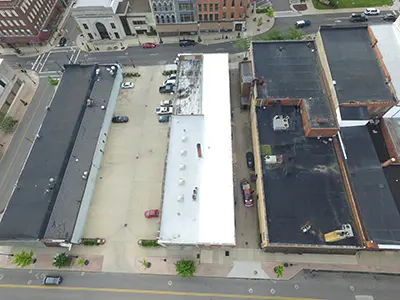
Nebraska business owners face significant cooling challenges during hot summers, with commercial buildings often requiring substantial energy for temperature control. Cool roof technology offers an innovative solution that can dramatically reduce energy costs while extending roof lifespan.
A.G. Roof Coatings is focused on teaming with our Nebraska neighbors to get the most value from their commercial roofing investment. Call 402-919-5793 today to schedule your consultation.
This article explores how cool roof systems work and why they’re particularly beneficial for Nebraska’s commercial sector.
What Is Cool Roof Technology?
Cool roofs are designed to reflect more sunlight and absorb less heat than standard roofing materials. Using highly reflective paints, sheet coverings, or highly reflective tiles or shingles, these systems maintain lower roof temperatures even during intense summer heat. Unlike conventional dark roofs that can reach temperatures of 150°F or more on hot days, cool roofs typically stay 50-60 degrees cooler.
Energy Savings for Nebraska Businesses
Commercial buildings in Nebraska can achieve substantial energy savings through cool roof implementation. Studies show that businesses can reduce peak cooling demands by 10-15% and cut annual air conditioning costs by up to 25%. For a typical 10,000-square-foot commercial building in Nebraska, this can translate to savings of $3,000-$5,000 annually on cooling expenses.
The Nebraska Energy Office recognizes cool roofs as an effective energy efficiency measure, with many installations achieving payback periods of 3-5 years through energy savings alone.
Beyond Energy Savings: Additional Benefits
Cool roofs offer Nebraska businesses several advantages beyond direct energy savings:
- Extended Roof Lifespan: By reducing thermal cycling and UV damage, cool roofs typically last 5-10 years longer than conventional roofing.
- Improved Indoor Comfort: Buildings with cool roofs maintain more consistent temperatures, improving working conditions and potentially boosting productivity.
- Reduced HVAC Equipment Strain: Lower cooling demands extend the life of air conditioning systems, reducing maintenance and replacement costs.
- Decreased Urban Heat Island Effect: Widespread adoption in commercial districts helps reduce ambient temperatures in urban areas like Omaha and Lincoln.
Considerations for Nebraska’s Climate
While cool roofs excel during Nebraska’s hot summers, some considerations apply to the state’s cold winters. Modern cool roof systems are designed to perform well year-round, and studies show that potential winter heating penalties are typically far outweighed by summer cooling savings. Additionally, snow cover during winter months naturally negates any reflective disadvantages.
Cool Roof Technology Experts
Many Nebraska utilities offer rebates and incentives for energy-efficient roof upgrades. The Nebraska Energy Office provides resources to help businesses identify available incentives, while federal programs like ENERGY STAR can provide tax benefits for qualifying cool roof installations.
For Nebraska commercial building owners looking to reduce energy costs, improve building comfort, and extend roof lifespans, cool roof technology represents a smart investment. With substantial energy savings potential and various system options to suit different building types, cool roofs offer a practical solution to rising energy costs while contributing to more sustainable business operations across the state.
To learn more about how Cool Roof technology can help your Nebraska commercial building, call 402-919-5793 and speak with an expert.
Cool Roof Technology FAQ
Will a cool roof work in Nebraska’s cold winters?
Yes. Modern cool roof systems are designed for year-round performance. While there may be minimal heating penalties during winter months, the summer cooling savings typically outweigh any winter disadvantages by a significant margin, especially for commercial buildings with large footprints.
How long do fluid-applied roof coatings typically last in Nebraska?
Quality fluid-applied roof coatings in Nebraska typically last 10-15 years depending on the specific product, application thickness, local environmental conditions, and adherence to recommended maintenance practices. While longer warranties are available, A.G Roof Coatings generally recommend customers opt for a 10-year warranty, while adhering to a preventative maintenance protocol, and budget for a recoat every 10 -15 years. We feel this approach is the most economical solution to extending the life of a roof. Feel free to ask about longer warranties available with roof coatings.
Are all fluid-applied roof coatings reflective enough for Nebraska’s summer heat?
Not all coatings are equally suited to Nebraska’s intense summer sun. While white coatings offer maximum solar reflectance (typically 80-88%) ideal for Nebraska’s hot summers, many manufacturers also offer colored options with moderate reflectivity that may be appropriate for buildings in partially shaded locations. For maximum energy efficiency benefits during Nebraska’s peak cooling season (when temperatures consistently exceed 85°F), local commercial roofing experts recommend white coatings that have a higher Solar Reflectance Index (SRI) value certified by the Cool Roof Rating Council.
Do cool roofs qualify for energy efficiency rebates?
Many Nebraska utilities offer rebates for commercial cool roof installations. Additionally, federal tax incentives may apply through programs like the ENERGY STAR qualified roof products program, potentially reducing upfront costs by 10-30%.




